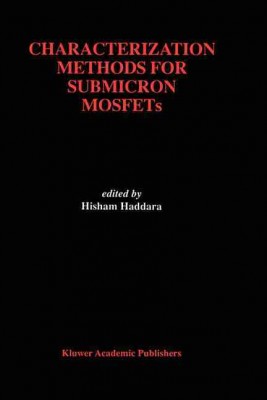| Characterization Methods for Submicron Mosfets 1995 Edition Contributor(s): Haddara, Hisham (Editor) |
|
 |
ISBN: 0792396952 ISBN-13: 9780792396956 Publisher: Springer OUR PRICE: $161.49 Product Type: Hardcover - Other Formats Published: January 1996 Annotation: The Metal-Oxide Semiconductor Field-Effect Transistor (MOSFET) is a key component in modern microelectronics. During the last decade, device physicists, researchers and engineers have been continuously faced with new elements making the task of MOSFET characterization increasingly crucial, as well as more difficult. The progressive miniaturization of devices has caused several phenomena to emerge and modify the performance of scaled-down MOSFETs. Localized degradation induced by hot carrier injection and Random Telegraph Signal (RTS) noise generated by individual traps are examples. It was thus unavoidable to develop new models and new characterization methods, or at least adapt the existing ones to cope with the special nature of these new phenomena. Characterization Methods for Submicron MOSFETs deals with techniques which show high potential for characterization of submicron devices. Throughout the book the focus is on the adaptation of such methods to resolve measurement problems relevant to VLSI devices and new materials, especially Silicon-on-Insulator (SOI). Characterization Methods for Submicron MOSFETs was written to provide help to device engineers and researchers to enable them to cope with the challenges they face. Without adequate device characterization, new physical phenomena and new types of defects or damage may not be well identified or dealt with, leading to an undoubted obstruction of the device development cycle. Audience: Researchers and graduate students familiar with MOS device physics, working in the field of device characterization and modeling. Also intended for industrial engineers working in device development, seeking to enlarge their understanding ofmeasurement methods. The book additionally addresses device-based characterization for material and process engineers and for circuit designers. A valuable reference that may be used as a text for advanced courses on the subject. |
| Additional Information |
| BISAC Categories: - Technology & Engineering | Electronics - Transistors - Technology & Engineering | Electrical - Technology & Engineering | Electronics - Circuits - General |
| Dewey: 621.381 |
| LCCN: 95050306 |
| Series: The Springer International Engineering and Computer Science |
| Physical Information: 0.63" H x 6.14" W x 9.21" (1.17 lbs) 232 pages |
| Descriptions, Reviews, Etc. |
| Publisher Description: It is true that the Metal-Oxide-Semiconductor Field-Eeffect Transistor (MOSFET) is a key component in modern microelectronics. It is also true that there is a lack of comprehensive books on MOSFET characterization in gen- eral. However there is more than that as to the motivation and reasons behind writing this book. During the last decade, device physicists, researchers and engineers have been continuously faced with new elements which made the task of MOSFET characterization more and more crucial as well as difficult. The progressive miniaturization of devices has caused several phenomena to emerge and modify the performance of scaled-down MOSFETs. Localized degradation induced by hot carrier injection and Random Telegraph Signal (RTS) noise generated by individual traps are examples of these phenomena. Therefore, it was inevitable to develop new models and new characterization methods or at least adapt the existing ones to cope with the special nature of these new phenomena. The need for more deep and extensive characterization of MOSFET param- eters has further increased as the applications of this device have gained ground in many new fields in which its performance has become more and more sensi- tive to the properties of its Si - Si0 interface. MOS transistors have crossed 2 the borders of high speed electronics where they operate at GHz frequencies. Moreover, MOSFETs are now widely employed in the subthreshold regime in neural circuits and biomedical applications. |